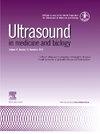Comparative Analysis of Common Carotid Artery Intima-Media Thickness and Lagrangian Wall Strain in Relation to Cardiovascular Risk Factors Using Ultrasound
IF 2.6
3区 医学
Q2 ACOUSTICS
引用次数: 0
Abstract
Objective
This study examines the relationship between carotid intima-media thickness (CIMT), carotid artery wall strain indices measured via ultrasound, and their associations with cardiovascular disease (CVD) risk factors in a low CVD risk population.
Methods
Eighty healthy volunteers (median age 35 y, 50% female) underwent carotid ultrasound imaging for CIMT and strain indices. Participants’ clinical data, including total cholesterol, low-density lipoprotein cholesterol, high-density lipoprotein cholesterol, triglycerides, high-sensitivity C-reactive protein, hemoglobin A1c, systolic blood pressure (SBP), diastolic blood pressure, body mass index and smoking status, were collected. Spearman Rho correlations assessed relationships between CIMT and strain indices. Multiple linear regression examined associations between strain indices and CVD risk factors, while Mann–Whitney U tests compared median differences between sexes. Statistical analyses were performed using SPSS.
Results
No significant associations were seen between CIMT measurements and strain parameters. After adjustment for CVD risk factors, several strain indices were significantly associated with CVD risk factors. Age was inversely related to all strain parameters. SBP was significantly positively related to axial and shear strain. Hemoglobin A1c was significantly inversely related to most axial and shear strain (all p values <0.05). These relationships are consistent with previous findings in the literature. We also found that BMI was positively related to all strain parameters, which may be due to increased compliance with more gradual arterial remodeling.
Conclusion
Strain parameters remained significantly related to several CVD risk factors in fully adjusted models. All strain parameters are associated with age. Axial and shear parameters are associated with SBP and hemoglobin A1c. These findings suggest that strain measures may represent early mechanical changes in the arterial wall and have potential for use as a research tool to characterize arterial health.
超声检测颈总动脉内膜-中膜厚度及拉格朗日壁应变与心血管危险因素的比较分析。
目的:探讨超声测量颈动脉内膜-中膜厚度(CIMT)、颈动脉壁应变指数与低危人群心血管疾病(CVD)危险因素的关系。方法:80名健康志愿者(中位年龄35岁,50%为女性)接受颈动脉超声成像检查CIMT和应变指数。收集参与者的临床数据,包括总胆固醇、低密度脂蛋白胆固醇、高密度脂蛋白胆固醇、甘油三酯、高敏c反应蛋白、血红蛋白A1c、收缩压(SBP)、舒张压、体重指数和吸烟状况。Spearman Rho相关性评估了CIMT与应变指数之间的关系。多元线性回归检验了应变指数与心血管疾病危险因素之间的关系,而Mann-Whitney U检验比较了两性之间的中位数差异。采用SPSS进行统计分析。结果:CIMT测量和应变参数之间没有明显的关联。调整心血管疾病危险因素后,多个应变指标与心血管疾病危险因素显著相关。年龄与各应变参数呈负相关。收缩压与轴向应变和剪切应变呈显著正相关。结论:在完全调整后的模型中,应变参数与心血管疾病的几个危险因素仍有显著相关性。所有的应变参数都与年龄有关。轴向和剪切参数与收缩压和血红蛋白A1c相关。这些发现表明,应变测量可能代表动脉壁的早期力学变化,并有可能用作表征动脉健康的研究工具。
本文章由计算机程序翻译,如有差异,请以英文原文为准。
求助全文
约1分钟内获得全文
求助全文
来源期刊
CiteScore
6.20
自引率
6.90%
发文量
325
审稿时长
70 days
期刊介绍:
Ultrasound in Medicine and Biology is the official journal of the World Federation for Ultrasound in Medicine and Biology. The journal publishes original contributions that demonstrate a novel application of an existing ultrasound technology in clinical diagnostic, interventional and therapeutic applications, new and improved clinical techniques, the physics, engineering and technology of ultrasound in medicine and biology, and the interactions between ultrasound and biological systems, including bioeffects. Papers that simply utilize standard diagnostic ultrasound as a measuring tool will be considered out of scope. Extended critical reviews of subjects of contemporary interest in the field are also published, in addition to occasional editorial articles, clinical and technical notes, book reviews, letters to the editor and a calendar of forthcoming meetings. It is the aim of the journal fully to meet the information and publication requirements of the clinicians, scientists, engineers and other professionals who constitute the biomedical ultrasonic community.

 求助内容:
求助内容: 应助结果提醒方式:
应助结果提醒方式:


